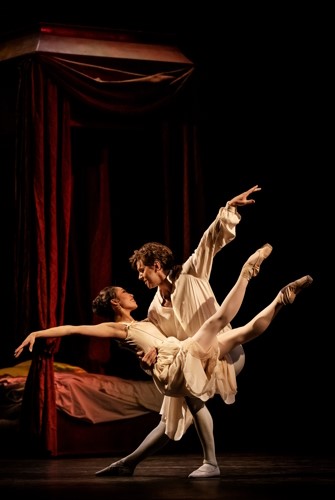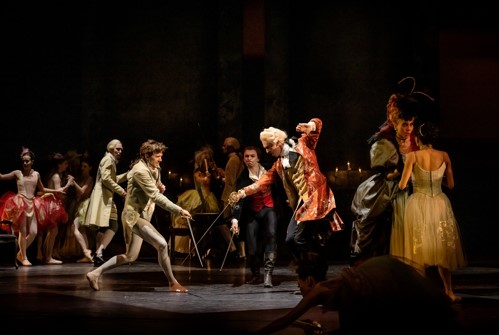Opera House, Stockholm
May 26, 2023
Kenneth MacMillan’s Manon created in 1974, continues to weave its magic providing a slew of dramatic roles against a volatile and violent backdrop. The Royal Swedish Ballet, founded in 1773 and celebrating its 250th anniversary this year, first presented the ballet in 1980. It makes a welcome return.
The central roles of Manon and Des Grieux challenge the best but Madeline Woo and Calum Lowden rose to the occasion. Over the passage of three acts, they run a gamut of emotions in addition to the technical challenges of MacMillan’s pas de deux. But the chemistry was evident and passions flamed, making this an evening to treasure.
Woo is a delicious Manon, arriving in the bustling streets of Paris starry-eyed and ready for love. The studious Des Grieux is equally smitten, and their first duet was electrifying. Both had their technique well in hand enabling the drama to take the lead. Staying fully in the moment as the characters, the necessary classical finish to the choreography was always in evidence.
Manon’s difficult reversal in affection, from true love to the lure of wealth is complicated by a hint of seductive wiles in her meeting with Monsieur G.M. but is somewhat redeemed with her sorrowful backward glance as she leaves Des Grieux’s lodgings draped in furs and jewels.
Manon only gets to fully understand the danger and cruelty that surrounds her in the final act when the vulnerability of her fragile body is evident. Des Grieux, his decency manifest in the poetic solos that MacMillan has created, is also little match for the corruption and his bungling attempt to cheat at cards is a sorry fiasco.
Their final duet, lost, destitute and stripped of their fine clothes brings them to the essence of their love. It is a true tragedy but a rip-roaring tale.
The opening image has Lescaut, Manon’s brother, seated centre stage draped in a black cloak like a spider in the middle of the web waiting to trap the weak and unwitting. Dawid Kupinski, after an uncharacteristically shaky start, quicky got into gear to deliver a devilish performance. The ‘drunken’ duet with his Mistress, Desislava Stoeva, was a treat of near misses and catches. Stoeva had a true grasp of the character, able to charm and perform to order but with acute understanding of the venality of her demi-monde existence.
This production, with costumes by Mia Stensgaard, creates something of a fancy dress party at Madame’s hotel, the setting for the second act. It’s all a little too light and frothy in bright pastel organza but the mood changes dramatically when Monsieur G. M. delivers Manon to be paraded and manhandled by the young blades under his supervision. The choreography is exquisite as she swoops and flies like a beautiful bird, but the message is clear; Manon is a bought object.
Daniel Norgren-Jensen, a superb actor, unfortunately seemed to miss the chill factor of a man who can horse trade in female flesh with no qualms. As Madame, the proprietor of the establishment, Nadja Sellrup was a treat: overdressed, over the top but with the steel core of the survivor. As the Gaoler Anthony Lomuljo succeeded in making the flesh creep as he sized up the pitiful dregs of humanity that disembark in Louisiana. MacMillan created one of the ballets darkest moments when Manon is dragged to his office and left to his mercy. Coldblooded and brutal he is thankfully brought to a sticky end.
There is a great deal of good choreography for the dancers and the men particularly showed excellent form in their many guises; from the street beggars led by virtuosic trickster, Hiroaki Ishida, to the gentlemen in the brothel and the soldiers on the docks. It’s a dark ballet but needs to be to represent the times. This also creates intense contrast with both the true love at the core of the ballet, the fine silks of the gentry and the charm in passages in Massenet’s score. Under Phillipe Béran’s baton, this fine line was set from the overture, played slower than usual, as he coaxed sweetness from the strings.
It was an evening of intense pleasure with much to savour; one also clearly enjoyed by the King of Sweden, Carl XVI Gustaf, who watched from his royal box and actually stood up to applaud at the curtain calls!



